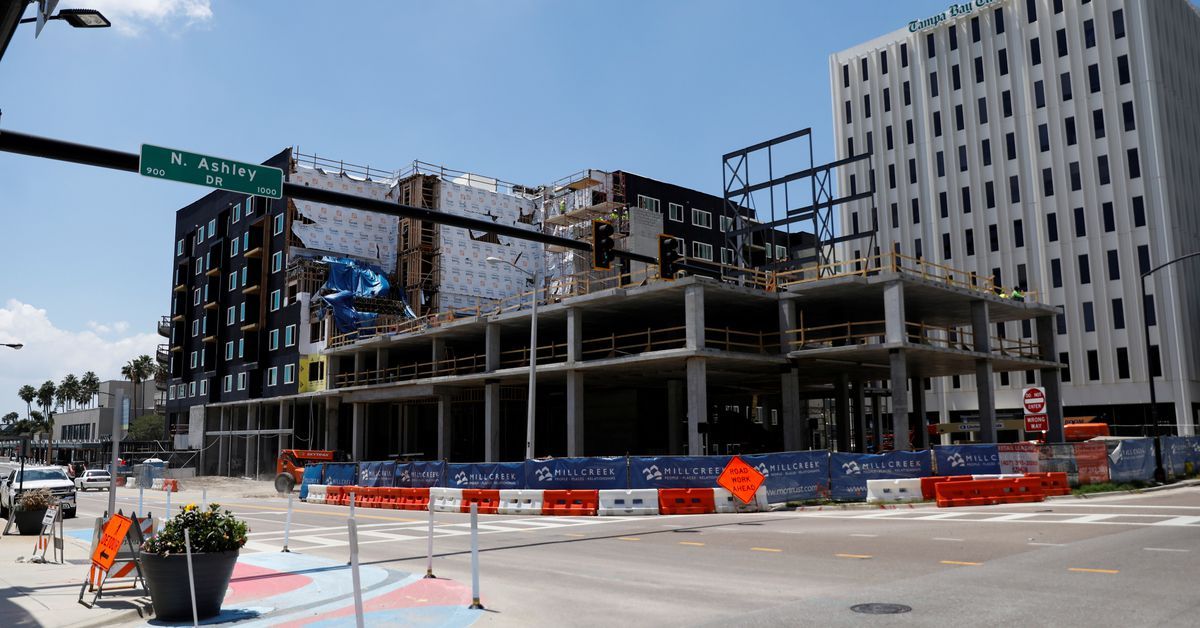New US home construction surges by most in 3 decades in May
June 20 (Reuters) - Groundbreaking on U.S. single-family homebuilding projects surged in May by the most in more than three decades and permits for future construction also climbed, suggesting the housing market may be turning a corner after getting clobbered by Federal Reserve interest rate hikes.
Still, even with the Fed skipping a rate hike this month for the first time since early 2022, credit conditions remain in the process of tightening, and that could make it challenging for builders heavily reliant on construction and development loans to keep pace with May's rebound in the months ahead.
Indeed, economists noted that multifamily construction projects that had secured financing last year contributed to May's gains and may level off as the year progresses as new financing becomes harder to obtain.
Housing starts rose to a seasonally adjusted annual rate of 1.631 million units last month from April's downwardly revised 1.34 million, the Commerce Department said on Tuesday. May's rate was the highest since April 2022, which was then the highest since 2006.
The 291,000-unit increase in starts was the most since January 1990, and the 21.7% rise was the largest percentage gain since October 2016.
Reuters Graphics
"While housing starts data tend to be volatile and this figure may be revised down in coming months, the enormity of the increase suggests that builders are broadly expanding operations this summer," Nationwide Senior Economist Ben Ayers said in a note.
Starts rose by double-digit margins in the South, Midwest and West while declining by nearly 19% in the Northeast. Single-family starts were up 18.5% with multi-family projects of five units or more climbing 28.1%.
Not all economists were convinced May's upswing represented the start of a continued surge.
"The strength is so far off trend that it calls sustainability into question," Jefferies U.S. economist Thomas Simons wrote. He noted the nearly 67% surge in starts in the Midwest, for instance, may be the product of rebuilding efforts after a damaging spring tornado season, which is unlikely to be repeated.
The housing market has taken the biggest hit from the Fed's fastest monetary policy tightening campaign since the 1980s, but recent data have suggested the worst may have passed.
A survey on Monday showed the National Association of Home Builders/Wells Fargo Housing Market index in June rose above the midpoint mark of 50 for the first time since July 2022 as a dearth of previously owned homes supported new construction. The index has rebounded by 77% since December.
NAHB
The average rate on the popular 30-year fixed mortgage has come down somewhat from last November's high above 7%. It averaged 6.77% in the latest week, according to data from the Mortgage Bankers Association.
But tightening credit conditions could make it harder for builders to access funding for new projects, a prospect NAHB's chief addressed alongside the association's data release on Monday.
"(A)ccess for builder and developer loans has become more difficult to obtain over the last year, which will ultimately result in lower lot supplies as the industry tries to expand off cycle lows," NAHB Chairman Alicia Huey said in a statement.
After lifting rates by 5 percentage points since March 2022, the Fed this month took a breather to assess the effects of its actions taken so far, though rate hikes are likely to resume next month with inflation still too high.
Nonetheless, most Fed officials see only one or two more quarter-point rate hikes as necessary, and businesses in rate-sensitive sectors like housing are showing signs of upward momentum as a result.
Permits for future construction, for instance, rose 5.2% to the highest since October at 1.491 million units, led by a 27.1% surge in the Northeast. Permits for single-family projects rose 4.8% while multi-family were up 7.8%.
Bill Adams, chief economist at Comerica Bank, said home construction is set to add to U.S. economic growth in the second half of this year. Residential construction has been a drag on gross domestic product growth for eight quarters in a row.
Reporting by Dan Burns; Editing by Conor Humphries and Andrea Ricci
Our Standards: The Thomson Reuters Trust Principles.
Source: Reuters.com


